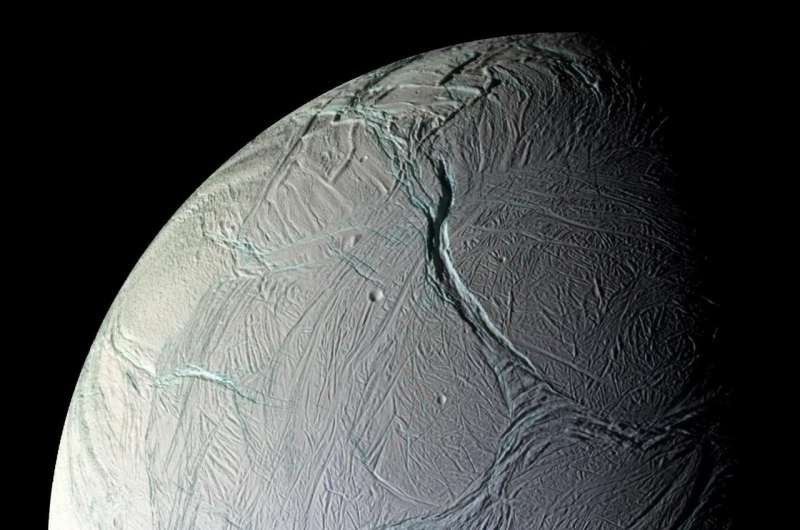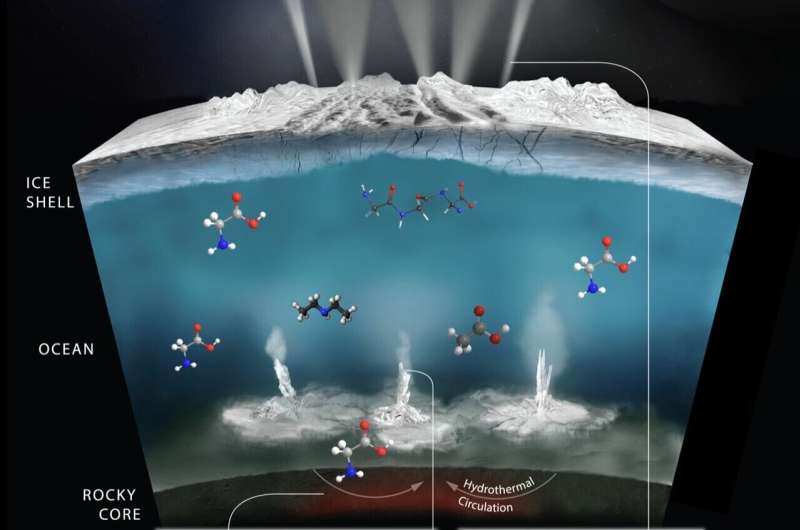This article has been reviewed according to Science X's editorial process and policies. Editors have highlighted the following attributes while ensuring the content's credibility:
fact-checked
trusted source
proofread
Discovery of biomarkers in space—conditions on Saturn's moon Enceladus simulated in the laboratory

In 2018, very large organic molecules were discovered in ice particles on Saturn's moon Enceladus. It is still unclear whether they indicate the existence of life or were created in some other way. A recent study could help to answer this question. It is possible, that conditions that support or maintain life in extraterrestrial oceans could leave molecular traces in grains of ice.
The research on this was conducted at the FU Berlin, and the lead scientist, Dr. Nozair Khawaja, has recently relocated to the University of Stuttgart. The work is published in the journal Philosophical Transactions of the Royal Society A: Mathematical, Physical and Engineering Sciences.
The cradle of life on Earth was probably located in a hot-water vent at the bottom of the ocean. "In research, we also speak of a hydrothermal field," explains Dr. Nozair Khawaja from the Institute of Space Systems (IRS) at the University of Stuttgart. "There is convincing evidence that conditions prevail in such fields that are important for the emergence or maintenance of simple life forms."
It is possible that such vents also exist on a celestial body that is located not that far away from our home planet by cosmic standards: Saturn's moon Enceladus. This moon measures around 500 kilometers in diameter and its surface is covered with a 30-kilometer-thick shell of ice.
In 2005, scientists discovered a huge cloud of ice particles above its South Pole. Three years later, NASA's Cassini space probe flew through this cloud. The probe's measuring instruments revealed something astonishing: The composition of the particles strongly suggests the presence of a liquid water ocean beneath Enceladus' icy crust.
Enceladus' ocean contains organic molecules
Khawaja worked together with planetologist Professor Frank Postberg from the Freie Universität (FU) Berlin to analyzse the data from the Cassini mission in detail. They explain, "In 2018 and 2019, we encountered various organic molecules, including some that are typically building blocks of biological compounds."
The data was recorded with a low-resolution measuring instrument from Cassini. Nevertheless, this could indicate that the ocean on Saturn's moon Enceladus is full of organic molecules. "And that means it is possible that chemical reactions are taking place there that could eventually lead to life."
Researchers also suspect there are hydrothermal fields located at the bottom of Enceladus' ocean. It was previously unclear whether the organic molecules discovered were formed in these fields. Khawaja, together with his colleagues Lucia Hortal and Thomas Sullivan, has been searching for a way to answer this question.

"To this end, we simulated the parameters of a possible hydrothermal field on Enceladus in the laboratory at the FU Berlin," says Khawaja, who has recently moved from the FU Berlin to the University of Stuttgart. "We then investigated what effects these conditions have on a simple chain of amino acids." Amino acids are the basic building blocks of proteins and the basis of all life as we know it.
Temperatures of 80 to 150 degrees Celsius and a pressure of 80 to 100 bar prevailed in the test apparatus—around a hundred times higher than on the Earth's surface. Under these extreme conditions, the amino acid chains changed in a characteristic way over time.
But is it even possible to detect these changes with the measuring instruments on space probes? In other words, do they leave behind an unmistakable marker that we should be able to find in the data from Cassini (or future space missions)?
Hydrothermal fields leave distinct traces in the measurement data
The measuring instrument on board the Cassini space probe, the Cosmic Dust Analyzer, analyzes dust and Enceladus ice particles in space that travel at speeds of up to 20 kilometers per second. The high-speed crashes between these particles causes the material to vaporize and the molecules in it to shatter. The fragments lose electrons and are then positively charged. They can be drawn towards a negatively charged electrode, and the lighter they are, the quicker they reach it.
It is possible to obtain a so-called "mass spectrum" by measuring the transit time of all fragments. This can then be used to draw conclusions about the original molecule.
However, it is difficult to apply this measurement method in the laboratory. "Instead, we employed an alternative measurement method called LILBID for the first time on ice particles containing hydrothermally altered material," Khawaja explains.
"This delivers very similar mass spectra to the Cassini instrument. We used this to measure an amino acid chain before and after the experiment. In the process, we came across characteristic signals that were caused by the reactions in our simulated hydrothermal field." The researchers will now repeat this experiment with other organic molecules under extended geophysical conditions in Enceladus ocean.
Their findings make it possible to search the Cassini data (or the data from future missions) for such markers. If found, this would be further evidence of the existence of a hydrothermal field on Enceladus. This also increases the probability that life can develop and survive on Enceladus.
More information: Nozair Khawaja et al, Laboratory characterization of hydrothermally processed oligopeptides in ice grains emitted by Enceladus and Europa, Philosophical Transactions of the Royal Society A: Mathematical, Physical and Engineering Sciences (2024). DOI: 10.1098/rsta.2023.0201
Provided by University of Stuttgart





















